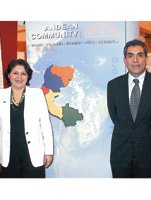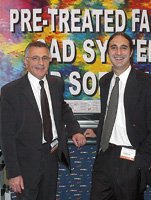Tech, Sourcing the Main Focus at New March Material World
MIAMI BEACH—The evolving global marketplace was well-reflected during Material World Technology Solutions, held March 17–19 at the Miami Beach Convention Center in Miami Beach, Fla. For its new spring edition, the now semiannual fabrics and sourcing show focused on emerging technologies, as well as the usual blend of sourcing opportunities and fabrics and trim suppliers.
The presence of the industry’s leading software and technology providers—including SAP America, Gerber Technology, Lectra, New Generation Computing, Investronica and a large contingent of offshore factories from South America—signaled that the apparel industry is ready to gain efficiency to compete in the world market place.
“The Information Technology element is important to the industry today, and we wanted to provide a home for these companies,” said Tim von Gal, executive vice president and partner of show producer Urban Expositions.
Though attendance figures were not available at press time, von Gal said preliminary estimates showed traffic was on par with the last Material World event in October. “We’re pleased with the way the show has gone,” he said.
Von Gal said strong feedback was bolstered by a seminar schedule that included presentations by Forrester Research, Koret/Kellwood, Gartner Inc. and Reebok International Ltd.
Most exhibitors said show traffic ranged from moderate to brisk.
Newtown Square, Pa.-based SAP said it was busy throughout the show giving presentations on its supply-chain, resource- planning and customer-relationship management solutions. The tech giant, which counts 11 of the top 15 apparel and footwear companies as its clients, has been on a campaign to attract more small and mid-size apparel companies.
“People know us for working with companies like Nike, but about 75 percent of our business is with companies in the $100 million to $500 million range,” said Ester Lutz, vice president of business development.
Lectra also exhibited its full range of software products. The company showed its 3VM visual-merchandising software, which drapes, builds and organizes clothing catalogs so users can change colors and styles at the click of a button.
“CAD/CAM is kind of saturated right now,” said Gina Sanchez of Lectra’s Los Angeles office. “A lot of companies are looking at electronic cataloging both for their B2B and B2C needs.”
Los Angeles-based DigiFab Systems showed its latest line of treated fabrics and ink-jet textile printers, which apparel companies have been using during sample cutting.
“It’s becoming more important because of the time-effectiveness element within the apparel industry,” said software engineer Alex Izmirlian of DigiFab. “About 80 percent of designs never make it into production, so we’re focusing on speed and quality.”
Andean nations lead sourcing contingent
About 60 factory representatives from Peru, Colombia, Ecuador, Bolivia and other Andean nations touted their participation in the Andean Trade Promotion and Drug Eradication Act (ATPDEA). The act eliminates the 20 percent-plus duties on the textiles that the region is known for, including cotton and llama fibers.
ATPDEA has helped boost business for Andean factories by about 20 percent since the act was signed last fall, said Fernando Albareda, commercial counselor for the Consulate General of Peru. New players in Bolivia and Ecuador have also benefited from the agreement.
Colombian factories, known for their twills and denims, have experienced a similar surge, said Sylvia Reyes, marketing director for the Colombian Trade Bureau in Miami.
Despite the trade advantages, however, Reyes said there is still a stigma about safety in Colombian factories because of drug-trafficking issues. To deal with the problem, Colombian apparel and textile trade groups have established anti-smuggling monitoring programs that ensure security during every stage of production, and much of the process is videotaped, she said.
Regional textile market
Many fabric exhibitors said they were pleased with the new spring show.
“You need two shows a year because you have two seasons,” said April Booth, national sales manager for Eclat Textile Co. of Los Angeles. “This show is good for us because I think it’s more of a knitwear show as opposed to New York, which is more of a wovens show.”
Booth said Eclat was getting lots of inquiries from regional swimwear and fitnesswear makers that were looking for microfibers and stretch materials.
Similarly, Pearl Ann Marco of de Marco Fabrics of New York and Los Angeles said the show helped the company build its regional business.
“In this area, they want lighter-color fabrics,” said Marco. “There’s lots of demand for swimwear and stretch fabrics. But there is a dress market too. And we’re seeing people coming here because they don’t want to travel to New York.”
























